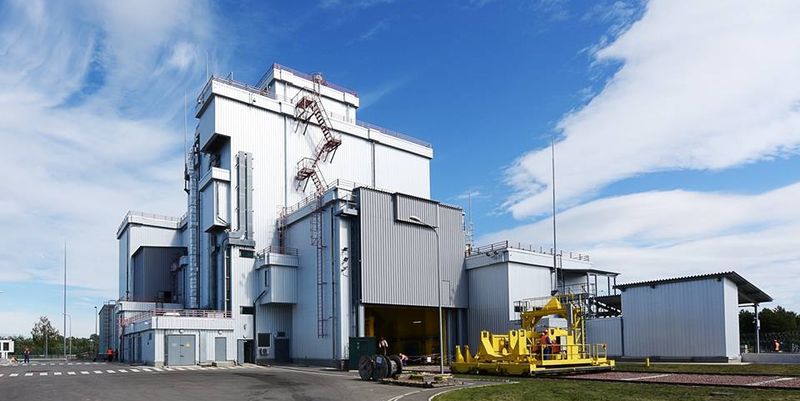In the photo: the new storage for spent nuclear fuel in Chornobyl.
Since this year, the state-controlled company EnergoAtom has stopped to take spent nuclear fuel to Russia for storage. The statement to this effect was made by Petro Kotin, the acting president of EnergoAtom. According to him, the company is no longer using Russian radiochemical plants for storage purposes. Kotin stressed, “We’ve decided to refuse completely from taking spent nuclear fuel to Russia. This measure strengthens considerably the energy security of our state”.
The new centralized storage facility is reported to be able to take the first batch of such fuel this July. Last December, the EnergoAtom Company completed the construction of the infrastructure including specially-equipped buildings where the spent fuel from the Chornobyl restricted zone will be kept. Today, the commissioning and testing of the equipment are in progress there.
The centralized storage will be launched in the second quarter of this year as soon as the 43-km-long branch line will be built to connect the facility with the rest of the railroad system of Ukraine. The facility is designed to keep spent fuel from all Ukrainian nuclear power plants under safe conditions for the term of a hundred years. Officials in the government say that the commissioning of the facility will make it possible to save almost 200 million dollars a year which Ukraine had to pay Russia for the storage of spent nuclear fuel.
In 2018, the EnergoAtom Company signed a seven-year contract with Westinghouse Electric for deliveries of nuclear fuel. Under the contract, the company pledges to supply seven out of 15 Ukrainian nuclear reactors with fuel during the period from 2021 to 2025. Thus, in July 2018, one of the reactors of the South Ukraine nuke began to work on American fuel provided by this company. In December of that year, the fifth reactor of the Zaporizhya nuclear power station was fully converted to American fuel.
Last September, EnergoAtom signed another contract with Westinghouse Electric to provide the Rivne nuclear power station with fuel. Thus, Ukraine complies with the International Atomic Energy Agency (IAEA) recommendations which require that the share of one supplier of fuel should not exceed 70% in the general structure of suppliers. In accordance with the Ukrainian State Statistics Service, the share of Russian nuclear fuel supplied to Ukraine comprised almost 72% in 2018, and a year later it was reduced to 57%.
Minister for Energy and Coal Industry, Yuri Vitrenko, announced recently that Ukraine was going to refuse entirely from Russia’s TVEL and transfer to American nuclear fuel by the year 2023. The minister stressed that this measure would become an important element of the national security of Ukraine.
As expected, Russia has repeatedly expressed its “concern” over the conversion of the Ukrainian nukes to American nuclear fuel. The Foreign Ministry of the Russian Federation stated that Ukraine ignores “nuclear safety considerations”. Aleksei Likhachev, the director general of RosAtom, repeatedly stressed that Ukraine’s decision to buy fuel from the American company Westinghouse would allegedly lead to technological and ecological risks.
However, Ukraine does not agree with such conclusions. For instance, Ukrainian specialists in nuclear and radiation safety maintain that cooperation with Westinghouse is not limited to fuel purchases only. The deal also includes modernization and modification measures to make the work of the Ukrainian nuclear power stations safe.
“Russian suppliers of nuclear fuel regard Westinghouse as their chief competitor in Ukraine. No wonder, they make from time to time warnings about some impending danger or the threat of a technogenic catastrophe that may be brought about by a change of fuel”, wrote Volodymyr Omelchenko, an expert on energy issues at the Kyiv-based Razumkov Center for Economic and Political Studies.
EnergoAtom is an operator of all four nuclear power stations in Ukraine. The company operates 15 nuclear reactors equipped with water power facilities with the total capacity of 13.835 GW and provides for almost 55% of Ukraine’s needs in electricity.
The newspaper Voice of Ukraine.








